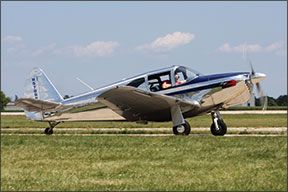The original Swift wasn’t. With but 85 HP, the post-war, two-seat, tailwheel retract would barely climb out of its own way. However, its fighter-like handling, good looks and aerobatic ability, plus a management decision to almost immediately certify a model with 40 more HP, generated an enduring core of aficionados. Globe and its follow-on manufacturer, Temco, created a true sport airplane that is demanding of its pilots, rewarding to those who can fly rather than drive, and proved to be amazingly amenable to being extensively modified.
For the buyer considering a Swift, the question isn’t so much whether but which. Although there are only about 700 in the U.S., few aircraft have as many STCs and field approvals for conversions as the Swift. The newest Swift is more than 60 years old, and the typical airplane has seen so many mods that we can easily say that no two Swifts are identical.
Model History
Swift history is rich, complex, sometimes a bit vague and seems possessed of its share of Texas tall tales. As accurately as we can determine, the story begins in the mid 1920s, with a Texan named John Kennedy (no known kin to the political Kennedys) who established Globe Laboratories, which made a serum to combat black leg disease in cattle. Kennedy did well, even during the Great Depression, and initially invested his wealth in thoroughbred horses. Becoming bored with horses, and still being flush, he decided to invest in aviation.
Kennedy bought into Bennett Airplane Corporation, a company that was attempting to build a “plastic” light twin. It wasn’t plastic as we know it, but rather Duramold (or Duraloid, reports vary), which was a cutting-edge process of impregnating wood with a phenolic called Hazeklite and bonding it under pressure to make an extremely strong, light structure. A certain Howard Hughes made his HK-1 Hercules largely of Duramold.
The plastic twin lost out to the Beechcraft AT-10 in competition for a military production contract; largely putting paid to the Bennett company’s prospects.
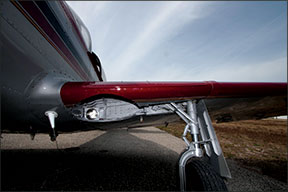
However, just about that time Kennedy got to know one Rufus “Pop” Johnson, who had built his own wood-and-fabric copy of the Culver Cadet and was looking for someone to put it into production. Bennett Airplane Corporation slid into bankruptcy. Kennedy took it over and reorganized it as Globe Aircraft Corporation, intending to build Johnson’s airplane, to be called the “Swift.”
The original Swift had a Duramold-covered main spar, retractable, conventional gear that were hydraulically actuated, manually operated split flaps, an 80-HP Continental engine and an adjustable, wood prop. It appeared in the 1941 issue of Jane’s All the World’s Aircraft as capable of carrying two people 600 miles at 130 MPH. Service ceiling was claimed as 16,200 feet.
During the 1941 developmental program, Globe’s marketing was so successful that it generated orders valued at over $1 million and lined up some 40 dealers. At the same time, management disagreements lead Pop Johnson to depart and eventually form a company where he could build airplanes as he wished, going on to design the sometimes frightening Johnson Rocket. With the U.S. entry into World War II, Swift development stopped. Globe built Beechcraft AT-10s under contract as we’ll as components for the Curtiss Commando and Lockheed Lightning.
In 1944, Kennedy had Globe engineers rework the Swift design. What emerged, the GC-1A, was something that looked similar to the pre-War
Swift, but was all-metal, with hydraulically operated landing gear and flaps and an 85-HP Continental engine.
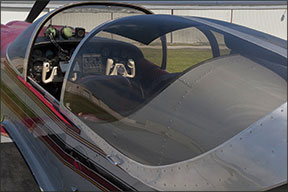
In January 1945, the prototype GC-1A Swift began flight testing. To facilitate construction, a drag-inducing, angular break had been added just aft of the cockpit—testing revealed it meant slower cruise speeds than had been observed with the pre-War model. Nevertheless, with a gross weight of 1570 pounds, it was capable of 120 MPH on 85 HP. Flight testing also uncovered an inability to meet CAA requirements for approval for intentional spins. Facing time and resource pressure, the decision was made to stop trying for spin certification and placard the Swift against intentional spins.
In May 1946, the new Swift was awarded its Type Certificate. Pre-certification demand had been far beyond Globe’s dreams and capacity. It contracted with Texas Engineering and Manufacturing Company (Temco), which was made up of laid-off engineers and workers who had been building the North American P-51, to also build Swifts.
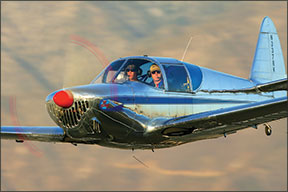
The GC-1A immediately demonstrated notable shortcomings in service—a stunning absence of short field performance and terrible ground handling due to a full swiveling tailwheel.
Globe managed to certify a 125-HP version, the GC-1B—with a steerable tailwheel—in a matter of months, thus solving the GC-1A’s problems. But sometimes early damage to an airplane’s reputation, deserved or not, can’t be fixed. The bottom fell out fast. By the end of 1946, there were unsold airplanes filling fields.
About that time Temco figured out that Globe was selling the airplanes for $300 less than they cost to build. The price had to be increased, further hurting sales. Globe went bankrupt in early 1947, owing Temco some $1.3 million. Temco acquired what assets there were, made improvements to the Swift, including a better rollover structure, hat shelf and rear windows, and managed to sell the airplanes at a profit through the middle of 1951.
Sources disagree on the total number of Swifts built—it is probably between 1500 and 1521 airplanes.
In the late 1940s, Temco also developed and sold a few copies of a tandem-seating, 145-HP military version of the Swift called the T-35 Buckaroo.
The Swift Type Certificate and tooling was sold to Univair, which built parts rather than airplanes and helped keep the fleet in the air. Yet the Swift became almost a schizophrenic—every airport seemed to have one in the weeds, corroding away while others were lavished with affection that included a stunning assemblage of modifications from ever-larger engines through airframe clean ups and system improvements.
In 1968, a Swift owner, Charlie Nelson, formed what evolved into the Swift Museum Foundation to support Swift owners. In the 1970s, perhaps because the Swift proved to be so friendly to performance-enhancing modifications, the airplanes steadily became more popular. In 1980, Nelson’s organization purchased the Swift Type Certificate and tooling, moving them to McMinn County Airport in Athens, TN, now the home of the Swift Museum and source of Swift parts, institutional knowledge, owner guidance and an annual fly-in.
Flying the Swift
We cannot over-emphasize the need for a checkout by a knowledgeable Swift instructor. While most of the behind-the-hangar denigrating tales of the Swift aren’t true (“it won’t take off in a left crosswind,” “it rolls upside down if you stall it”), it was never a plain vanilla airplane. A lot of over-confident, high-time pilots have wound up in the buckwheat because they did not respect the Swift’s need for attention on the ground or have been stuffed into the ground after a stall in the pattern.
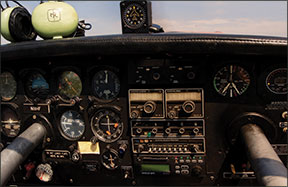
The Swift Museum Foundation offers substantial guidance to first-time Swift flyers and buyers. The website www.saginawwings.com has several pages of advice from Swift pilots on flying the airplane as we’ll as a list of Swift instructors.
John Davis, retired airline pilot and certified Swift instructor, with more than 3000 tailwheel hours and more than 1000 hours in Swifts, made the need to respect a Swift clear to us in an interview some years ago, “The Swift is not just another tailwheel airplane. This is a high-performance, retractable-gear airplane, whereas most other tailwheel airplanes have fixed gear with fixed-pitch propellers—they are not considered high performance.”
Davis stressed, first of all, that three-point landings are not the routine. “When you get the Swift slow, with the gear and flaps extended, it is in a higher drag condition than a lot of pilots are used to. It doesn’t take much for the airplane to slow further, very quickly. If you are still two or three feet in the air when this happens, a high sink rate develops faster than you can believe, and you will drop the airplane in for a hard landing or worse.”
In our research into the Swift, we found that, unlike virtually all other single-engine tailwheel airplanes, no one recommended making three-point landings until building up significant experience in type. In three-point attitude, touchdown is very near the stall, the drag increase during the round out is not linear, and the horizontal stabilizer and elevator lose effectiveness in ground effect. There is little room for error.
While the stories of the airplane being unable to take off with a left crosswind are not true, it is challenging. Raising the tail too early means the rudder may not be effective enough, by itself, to stop the airplane from turning left—right brake application may be needed, which can go wrong if not done judiciously. We were told to keep the tail on the ground until achieving at least 40 MPH.
The particular engine installed, from 85 to 220 HP, means that specialized knowledge in the handling, and modified systems—notably fuel tankage—is needed.
On top of that, the human factors design of the original airplane was lousy—the landing gear and flap switches are below the pilot’s control wheel; the flap switch is shaped like a wheel, while the gear switch looks more like a flap.
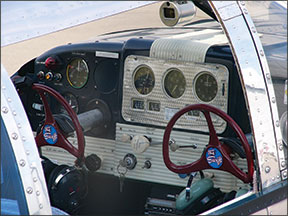
Once in the air, the airplane is delightfully light on the controls. It is aerobatic with snap rolls approved but spins prohibited. Our opinion regarding committing akro in a 65-year-old, light airplane is that it should be done only after assuring oneself of the integrity of the airframe. The sheer joy of flying a Swift overcomes the travails one can suffer when it is on the ground and is the reason, we believe, that so much modification attention has been lavished on them.
Cruise, in the 125-HP, GC-1B can be as high as 140 MPH at 2600 RPM. The roll rate is pleasantly rapid, and elevator forces are light enough that a pilot new to the Swift may inadvertently stall the airplane in a steep turn while just intending to apply back pressure to keep the nose up.
So long as the ball is centered, the stall is tame, although the airplane is so deep into the high-drag regime that the nose must be lowered noticeably in the recovery—it will not power out of a stall—some altitude loss must be accepted or there is risk of a secondary stall. If the ball is not centered when the stall breaks, the Swift will roll off smartly, requiring assertive application of appropriate rudder and nose-down elevator.
Even with the light controls, the Swift is stable in cruise—it will stay where you put it. We received reports that it is a satisfactory IFR platform.
As a tradeoff for the unpleasant unpredictability of three-point landings, wheel landings in a Swift are easier than in most other tailwheel airplanes. It does not seem to want to bound back into the air if things are not done precisely right as with the spring-gear airplanes. Once the tail comes down, the view over the nose isn’t great—it’s blind anywhere to the right of almost straight ahead. S-turns are necessary when taxiing.
With mods that allow one to install 90-, 145-, 150-, 180-, 200-, 210- and 220-HP engines, close the leading edge slots, install a bubble canopy, replace the control wheels with sticks, enclose the gear, retract the tailwheel, rework the fuel system, increase the fuel system capacity and change the twist of the wings, to name a few, finding parts and someone to work on the airplane can vary from easy to impossible.
The Swift Museum Foundation has a parts department that sells airframe parts; it has OEM sales approval for Continental and Lycoming engines as we’ll as Hartzell and McCauley props.
Because the airplanes tend to be highly modified, a pre-buy inspection should include a very detailed examination of the paperwork to assure all the 337s and STCs are in order.
Reader feedback was consistent in saying that having the airplane and its paperwork not line up can be very expensive if caught on the first annual and not on the prebuy.
The next issue is corrosion. The airplanes are now over 60 years old and corrosion is a major consideration. Mechanics find corrosion in the vertical fin, tailwheel area, around the horizontal stabilizer, on wing skins and the spar cap extrusions.
We counted 19 ADs on the GC-1A and 20 ADs on the -1B. When doing an AD search, look under Swift Museum Foundation rather than Globe or Temco, as the ADs are listed under the name of the Type Certificate holder. The vast majority of the ADs were issued prior to 1965, but that doesn’t mean all were complied with.
Performance
Don’t expect to find any handbooks on performance. With all the various engine-propeller combinations, the buyer has to fly the airplane to figure out what it can and cannot do. One problem may very we’ll be the legal weight and balance. Over the years, the Swifts have added more than a few pounds. We were told that very few Swifts can be found with an empty weight as low as 1200 pounds, most are around 1300 pounds. Some chubby Swifts with the big engines weigh more than 1500 pounds empty, which can cause a problem if they don’t have the STC for increased weights. The standard maximum is 1710 pounds, with an STC to increase weights to 1835 pounds for airplanes with engines up to 180 HP. 180 HP and above can be approved up to 1970 pounds. The problem becomes obvious.
The standard Swift has 26 gallons or 156 pounds of fuel in the main tanks. With two 170-pounders in the seats, it means the Swift has to weigh less than 1214 pounds for a legal weight—which may not be happening. You can have the Swift checked for unwanted pounds. We were told of mechanics who have taken as much as 125 pounds off a Swift. One found wiring harnesses left over from various additions. We were also told of finding every kind of insulation including household and automotive and three layers of paint.
MARKET SCAN
It’s difficult to set a standard price for a Swift because of the number of mods. However, for a GC-1B with the standard 125-HP engine, a good baseline is between $28,000 and $31,000. After that, prices can take off, although we’ve noted that prices of the top-end 200 HP and above Swifts (often referred to as the Super Swift) are not quite as high as they were five years ago. For example, on the saginawwings.com website, there are a number for sale ranging from $39,900 for a Swift with a 145-HP engine, to a 180-HP Swift with a long paragraph of mods posted at $80,000. We have seen Super Swifts change hands at prices north of $100,000 in the past. In our most recent scan of the ads, the highest asking price we saw was $98,000 for a 210-HP Swift with a boatload of mods.
Type Clubs
The Swift Museum Foundation, www.swiftmuseumfoundation.org, is, in our opinion, a must-join organization for anyone contemplating Swift ownership. It provides a wealth of technical knowledge and a supply of parts.
Owner Feedback
I have owned my Swift since 1981. I replaced the engine with a 210-HP Continental IO-360. I had previously owned a 145-HP Swift—there is no comparison between the two. With the 210-HP engine, performance is greatly enhanced. It responds unbelievably, and is more like piloting a military fighter rather than a civilian pleasure craft. In over 60 years of flying, I have owned and operated many type of aircraft, and my two favorites were the Learjet 35 and my modified Swift.
As a converted Swift, one must pay attention to the greatly increased torque, especially on takeoff. Once airborne, it flies like a homesick angel and, for me, it has no bad habits. In the air, it handles like any other plane, but I would highly recommend getting checked out by a CFI who is familiar with the aircraft prior to trying to fly one on your own.
For anyone considering purchase of a Swift, I recommend joining the Swift Museum Foundation, not only for the camaraderie, but also for ready access to repair parts and maintenance guidelines. As with any aircraft of this vintage, corrosion is of concern and due diligence on a pre-purchase inspection is certainly advised.
Jim Nixon
Via email
The Swift is a joy to fly. When my nephew, James Mack, and I restored our 1946 model, we heard lots of stories of how hard the plane is to fly. We found the handling straight-forward; it was not a beast.
It does require lots of attention and requires a checkout by someone that is familiar with the type. To me, it is no harder to fly than a Super Cub. It does great on well-groomed grass strips.
If you want attention, this is the plane. We get questions and comments everywhere we land. It is as close you can get to a warbird for under $100,000. An RV-8 is a close competitor to the Swift in terms of fun, but the Swift can be purchased for less.
The Swift Museum Foundation is a great source for everything to do with the plane. Join. They can help in all aspects of owning and flying the plane.
There are several knowledgeable Swift experts that are easily found. James and I are great examples of non-experts that still enjoy the plane.
As far as speed, the 125-HP planes are not that fast, but lots of fun getting there. The 160- and 180-HP ones have good cross-county speed and the 210 HP is the fastest. There are lots of mods for the type. Control sticks and landing gear updates were the mods at the top of our list.
Owning a Swift is one of the most enjoyable experiences I have had in aviation.
Steve Pittman
Via email
I have owned and operated a nearly original “stocker” for 18 years. I rely on a number of experts, including the Swift Museum Foundation, which has volumes of information including archived data on STCs, 337s, ADs, field approvals, qualified shops and instructors, owner lists and a full history of the Swift. It’s a well-run, solid organization that offers great support.
I was first attracted to the Swift for its flying qualities and light controls. It flies like a fighter and is commonly referred to as the poor man’s P-51. The hot rod nature of the Swift lends itself to the existence of examples that possess mods without paperwork, something buyers need to beware of. I understand that the Swift has more STCs than any other airplane.
I transitioned into the Swift with 200 hours total time, all in a Cessna 150. I found it an easy airplane to learn. I took 10 hours of dual with an instructor who had Swift time and 700 uneventful hours later, would highly recommend a Swift to anyone looking for a “pilot’s airplane.” Wheel landings are preferred, which make the airplane easy to manage.
I suggest choosing a mechanic who knows Swifts or at least is comfortable with working with a 65-year-old airplane.
The airframe is sturdy, stressed for plus 7 and minus 3.5 G, making it a platform for “gentleman’s” aerobatics, which are a lot of fun.
My airplane has been modified with a 145-HP engine, has 37 gallons of fuel, which gives me 3.4 hours at 140 MPH. It will do 154 MPH at full throttle. The 100 pounds of baggage capacity are adequate. My airplane has been a reliable and low cost. The O-300 engine and fixed-pitch prop have been bullet-proof and simple to maintain—same for the airframe and landing gear.
Terry McCartney
Via email
Swifts are great to fly, truly a mini fighter with very light controls that does “old man akro” really nicely. The big-engine Swifts climb we’ll and have good cruise speed. The ideal Swift is the 210-HP mod with sticks, bubble canopy, gross weight increase, aux tanks and Cessna 150 seats. My current Swift has all of those mods plus small wheels, flat panel, GAMIs, electric trim and Cleveland brakes. Some have clipped wing tips, smooth wing skins, leading edge slots covered over—the list goes on and on.
I suggest that any prospective owner contact the Swift Museum Foundation to get all the manuals, look on the saginawwings.com website for information and also visit with someone who owns a Swift.
As far as pilot skills, a competent tailwheel pilot should have no real problem transitioning. Most Swifts only have brakes on the left side, so you have to pick an experienced Swift instructor to evaluate your skills to make sure you are good enough to handle it on the ground.
The big-engine Swifts require a bit more care with speed control on landing. Wheel land until you get some experience before trying a three-pointer, and don’t flare too high as the airplane pays off quickly.
As far as maintenance is concerned, it helps to have someone who is familiar with Swifts to do the work, but if you take the time to learn its quirks—the website is helpful—it isn’t a hard airplane to maintain. Corrosion in the fuselage is something to check, plus it’s essential to make sure the paperwork for all the mods is in order.
Unless you live near sea level, the 125-HP Swifts are pretty marginal in climb and they don’t carry anything. I would not get anything less than a 150-HP Swift with the constant-speed prop. The 180-HP and 210-HP Swifts are the most preferred.
Bill Coombes
Via email
Owning a 180-HP Swift has been an adventure. I made more go-arounds in the first year than I had done in all the previous years of flying in the military, general aviation, Part 135 and the airlines.
With an HIO-360 (field approval) pulling the Swift around, I can expect about 3 hours flying before I land. I have 26 gallons in the wings and an aux tank holding 9 gallons. Leaned out, I burn about 9-10 gallons an hour. I routinely plan for a true airspeed of 135 knots.
The Swift is a conversation piece. Many cannot believe the airplane is over 60 years old (mine is a 1946 GC-1B). Once when I landed in Oklahoma, the tower asked when I was planning on departing. When I asked why they wanted to know that, the tower chief said they were closing the tower “…in about 30 minutes and we have never seen one of those things up close. Would you mind waiting a few minutes so we can see it?” I gladly obliged.
I ran across the Latin term, «ancora imparo», which roughly translates into “I’m still learning.” For the pilot who wants a Swift or who is flying a Swift, it is a good motto to adopt because the Swift is always ready to teach you a new lesson.
John Wiley
Atlanta, Georgia
As a long-time reader, I am glad to see the Swift get some attention. I have had four Swifts, the first purchased in the early 1980s for $8700. All Swifts fly great; with light control forces, it is good for light aerobatics or just having fun. I put Swifts and Corvettes in the same class. They are not the most practical things, but they sure are fun to have.
I am just an average pilot and have had no trouble in takeoffs or landings in wind. I have landed in wind that would have scared me if I knew it was that strong, but the airplane handled it well.
The Swift would be a good trainer for anyone about to get checked out in a real P-51 Mustang. The takeoff and landing characteristics are much the same. I once splurged and bought an hour in the P-51 Crazy Horse and it was so much like the Swift, I was right at home.
The retractable landing gear is mostly trouble free if you maintain it like any other retractable. It is electric/hydraulic; if you lose electric power, it has to be hand cranked down. I have done that once when a generator quit, and I ran the battery down before I caught it.
The Continental O-300 145-HP engine is a common mod for the Swift. The earlier ones had a pull-type starter engagement. The O-300D is more desirable because of its normal key-start capability, its alternator instead of a generator and a vacuum pump. You will find all of the small Lycomings up to 200 HP in Swifts, but the most popular big engine is the Continental IO-360 of 210 HP. A pure stock 85-HP Swift is rare—you can never have too much horsepower.
Some popular mods for Swifts are removing the control wheels and putting in sticks, removing the entire top of the cabin and replacing it with a bubble canopy, closing the slots in the wings, adding fuel capacity for the big engines, gross weight increase, full IFR panels. In short, they can be highly modified.
I am an A&P, so I usually do most of the actual work on my airplane and get an inspector to check everything and do the paperwork part. Annuals usually cost me $500 per year.
Part of owning a Swift is ego; it feels good when you stop somewhere for gas and the crowd comes out of the FBO to look, especially when the quarter-million dollar spam can beside you is being ignored.
Marvin Homsley
Via e-mail

